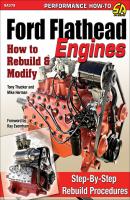Ford Flathead Engines. Tony Thacker
Чтение книги онлайн.

Читать онлайн книгу Ford Flathead Engines - Tony Thacker страница 9
Название: Ford Flathead Engines
Автор: Tony Thacker
Издательство: Ingram
Жанр: Сделай Сам
isbn: 9781613253496
isbn:
The late engines had insert main bearings and retained the integrated bellhousing. They have no perfect external identification; the easiest way to spot the difference is to look for the insert tang in the main bearing cap. Note the freeze plugs in this pan rail.
1937
The one-year-only 1937 engines were 21-studs with triangulated water passages and an integral bellhousing. New for 1937 was the relocation of the water pump from the head to the block.
The engineers at Ford finally overcame Henry Ford’s intransigence and positioned the pumps where they could work in the block rather than the head, pushing rather than sucking.
1938–1940
The change to 24-stud heads came in 1938, indicated by the triangulated water passages, but now there were only two stud holes, not three. This version still has the cast-in bellhousing, but notice the raised deck for the intake.
The 1940 Mercury engine is very similar to the Ford in that it has 24 studs, a cast-in bellhousing, and a raised intake deck. However, it has a slightly larger bore, affording 239 ci compared to 221 ci, and therefore 95 hp compared to the Ford’s 85.
1946–1948
The 1946–1948 59A 24-stud is identified by the round water passages. The raised deck is gone, because it offered no tangible benefit and complicated the manufacturing process.
Most 59As have “59” embossed on the cast-in bellhousing. However, the heads are often (but not always) embossed “59A” or “59AB.”
1949–1953
This is the desirable 8BA. Note that the water passages at the very rear of the block look like elongated tears. On earlier engines, they were small round holes.
The bellhousing for automotive applications was now a bolt-on stamped-steel unit; trucks had a bolt-on cast-iron bellhousing. This block is desirable because it offers many more transmission options.
The water pump on 1949–1953 blocks is different than that on 1946–1948 engines; it has an extra water passage as indicated. The thermostats were now located in the water necks and bolted to the front of the heads.
The 1949–1953 Merc crank (left) has a 5/8-inch oil clean-out hole, whereas the 3¾-inch stroke Ford crank (right) has a 3/8-inch clean-out. Most Canadian cranks have the 3/8-inch clean-out, so it is very confusing.
You can use a traditional hoist to move your flathead, and you can bolt it to a number of locations on the block, such as the intake (shown), the head bolts, or the exhaust manifold. Always be sure that the bolts have good purchase in the threads.
Let’s assume now that you’ve found a fairly good, complete, running engine that needs a rebuild. The first two pieces of equipment you need are an engine hoist and an engine stand. If you don’t already own these, it might be time to reconsider the project. A flathead Ford V-8 weighs 675 pounds. That’s not something you can lift and move easily. The hoist enables you to remove it from the car and into its new home; the stand gives you something to put it on.
An engine stand is often regarded as an essential tool, but Mike prefers to build his engines on a bench, which gives him room to spread out parts and tools on either side.
Mike does not use an engine stand for his rebuilds. He prefers a table with all his tools and parts within easy reach. That said, he has a hefty chain hoist above the table for lifting engines.
At this stage, you should also organize your work space and obtain any necessary special tools. Of course, it’s not essential to be organized, but it sure helps to keep the rebuild on track. Clear some space and use boxes for parts you remove. Don’t trash anything until the rebuild is complete. You never know what you might need as reference as you assemble the engine, and it’s good to have the old parts on hand to see how they look, how they performed, and how they fit.
Another essential tool is a camera, cell phone, or even iPad to record everything, СКАЧАТЬ